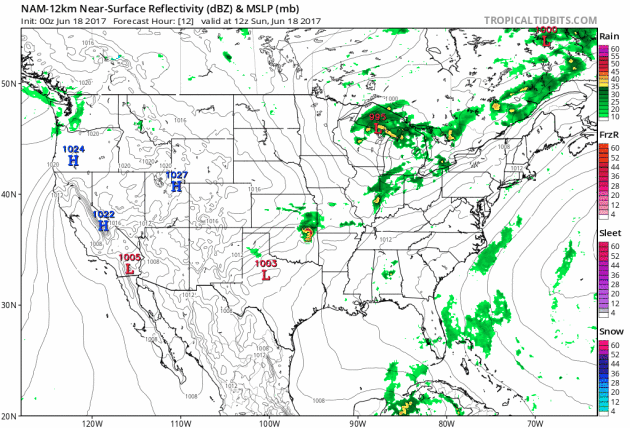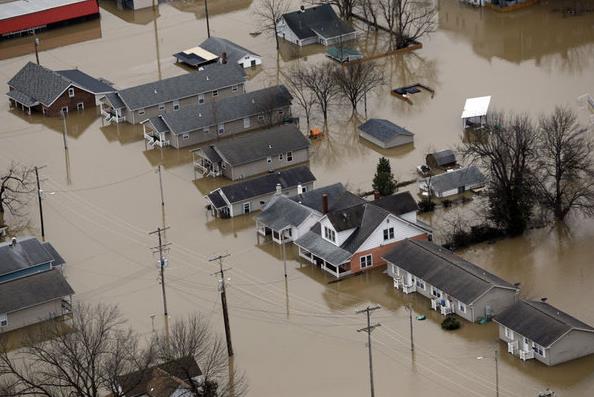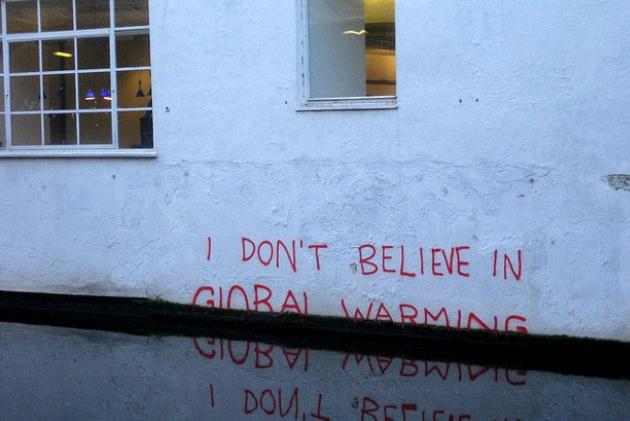June 18, 1850: Territorial Governor Ramsey reports that about halfway between Ft. Ripley and Ft. Snelling on the Mississippi a severe hail storm occurred in the evening. One or two hailstones picked up were as large as hen’s eggs and he thought he saw one about the size of a 'musket ball.'
Psychology of Weather Prediction - More Free A/C
Most days it pays to be a little pessimistic, to err on the side of...less. Exhibit A. Saturday was a smidge nicer than predicted. Sunshine lingered longer - storms held off until later. This seems almost acceptable on a weekend. But if the weather turns out WORSE than predicted, run for the hills. People remember, especially on a summer weekend.
I love all of Minnesota's 14 seasons, but I'm especially fond of summer. June is energizing; today we enjoy 15 hours, 36 minutes of daylight. The sun is as high in the sky as it ever gets, heating the ground, sparking numerous instability storms.
A wrinkle of unusually cold air aloft sparks a showers later today; Doppler will soon be freckled with blips and blobs - mostly light showers, a stiff wind and 60s. A touch of early October.
The weather models bring another push of fresh, clean Canadian air into Minnesota later this week; highs may hold in the 60s again next Saturday. Seems like a minor correction, after one of the warmest starts to June on record, statewide.
Sticky 80s in time for the 4th of July? Odds favor it, yes.

Near-Record Warmth First Half of June. Like clockwork, Dr. Mark Seeley has details at Minnesota WeatherTalk: "In contrast to May, the first half of June has been unusually warm, near record-setting in many places across Minnesota. For the Twin Cities Metro Area the mean temperature for the first half of June has been about 74.9 degrees F. Only 1976 was warmer, with a mean temperature of 75.1 degrees F. On a statewide basis the mean temperature for the first half of June was 69 degrees F. Only 1933 (71.4°F) and 1988 (70.4°F) were warmer. Within the Minnesota climate observation network 45 stations have reported daily maximum temperature records tied or broken so far this month, and 46 stations have also reported daily warm minimum temperature records tied or broken so far. Many places have reported multiple days with 90°F temperatures, as high as 97 degrees F at Rosemount and Waseca. MSP set a new record warm minimum temperature on June 10th with a reading of 77°F, breaking the old record of 73 degrees F back in 1973. Milan also reported a record warm minimum on that date with a reading of 77°F. MSP also tied a record high dew point reading on June 13 with a reading of 74 degrees F..."
Tuesday Highs. Hotter in Phoenix than Death Valley? Good grief. Be careful out there. Map: Aeris AMP.
Record Territory. High temperatures early next week in metro Phoenix will come within a couple degrees of the all-time record of 122F, set on June 26, 1990.
Highlights:
- Unusually hot summer temperatures have become more common across the contiguous 48 states in recent decades, with western regions setting records for several extreme heat events in the 2000s. They have a become a leading cause of weather-related mortality.
- There has also been a dramatic increase in nighttime temperatures in the US, reducing the number of critically important relief windows during heat waves.
- The more extreme the heat wave, the more likely the event is due to global warming. Eighty-five percent of recent record-hot days globally are now attributed to climate change.
Map credit: Aeris AMP.
Lightning Myths and Facts. NOAA has a page with some very good reminders:
Myth: If you're caught outside during a thunderstorm, you should crouch down to reduce your risk of being struck.
Fact: Crouching doesn't make you any safer outdoors. Run to a substantial building or hard topped vehicle. If you are too far to run to one of these options, you have no good alternative. You are NOT safe anywhere outdoors. See our safety page for tips that may slightly reduce your risk.
Fact: Crouching doesn't make you any safer outdoors. Run to a substantial building or hard topped vehicle. If you are too far to run to one of these options, you have no good alternative. You are NOT safe anywhere outdoors. See our safety page for tips that may slightly reduce your risk.
Myth: Lightning never strikes the same place twice.
Fact: Lightning often strikes the same place repeatedly, especially if it's a tall, pointy, isolated object. The Empire State Building is hit an average of 23 times a year.
Fact: Lightning often strikes the same place repeatedly, especially if it's a tall, pointy, isolated object. The Empire State Building is hit an average of 23 times a year.
Myth: If it’s not raining or there aren’t clouds overhead, you’re safe from lightning.
Fact: Lightning often strikes more than three miles from the center of the thunderstorm, far outside the rain or thunderstorm cloud. “Bolts from the blue” can strike 10-15 miles from the thunderstorm.
Fact: Lightning often strikes more than three miles from the center of the thunderstorm, far outside the rain or thunderstorm cloud. “Bolts from the blue” can strike 10-15 miles from the thunderstorm.
Myth: Rubber tires on a car protect you from lightning by insulating you from the ground.
Fact: Most cars are safe from lightning, but it is the metal roof and metal sides that protect you, NOT the rubber tires. Remember, convertibles, motorcycles, bicycles, open-shelled outdoor recreational vehicles and cars with fiberglass shells offer no protection from lightning. When lightning strikes a vehicle, it goes through the metal frame into the ground. Don't lean on doors during a thunderstorm...
Fact: Most cars are safe from lightning, but it is the metal roof and metal sides that protect you, NOT the rubber tires. Remember, convertibles, motorcycles, bicycles, open-shelled outdoor recreational vehicles and cars with fiberglass shells offer no protection from lightning. When lightning strikes a vehicle, it goes through the metal frame into the ground. Don't lean on doors during a thunderstorm...
File image: NASA.
Warmer Than Average July For Most of USA? Here is the latest prediction from NOAA CPC, the Climate Prediction Center, calling for a very warm July (with the possible exception of the Pacific Northwest).
Photo credit: "Research being performed at OSU hopes to improve the metrics for tornado prediction through the use of drones." Photo courtesy of Dr. Jamey Jacob.
- Keep the current WWA system as is;
- Make small to moderate changes; or
- Make a transformational change to the WWA system..."

Committee Passes First Round of Flood Insurance Bills. Here's an excerpt of a press release from The House Committee on Financial Services: "The House Financial Services Committee met today to begin consideration of several measures to reform and reauthorize the National Flood Insurance Program (NFIP), which is set to expire on September 30, 2017. “We cannot continue to call on the American taxpayer to bailout a program that is currently drowning in $25 billion of red ink and suffers a $1.4 billion annual actuarial deficit,” said Financial Services Committee Chairman Jeb Hensarling (R-TX). “These bills put the National Flood Insurance Program on a path toward actuarial soundness where all will be protected, no one will be denied a policy, all will benefit from competition, the NFIP will be sustainable, and the national debt clock will spin a little less rapidly...”
File photo of December 2015 flooding in Missouri: Associated Press.
Sharp Uptick in Wildfires Strains Great Plains Agencies. A story at Climate Central caught my eye: "...The spreading rash of fires across the flat and grassy states west of the Mississippi River has jolted a region unaccustomed them, even as it has been overshadowed in the news and dwarfed in firefighting budgets by bigger wildfires tearing up the West Coast. “The low frequency tends to lull all of us into a sense of complacency,” said Michele Steinberg, manager of wildland fire operations at the nonprofit National Fire Protection Association. “We have a long way to go with education, particularly for folks where they have not seen a lot of fire.” Because wildfires have been relatively rare in the Great Plains until recently, many states and counties have come to depend heavily on each other for assistance when they strike. “They rely on their neighbors,” Steinberg said. But the shared firefighting resources are becoming strained as more fires need to be fought. “You’re seeing conditions that are just right for not only ignition of fire, but also fire spread,” Steinberg said..."
Photo credit: "The Mule Ridge Wildfire in Arizona last year." Credit: U.S. Forest Service/Flickr.
Photo credit: "An aerial view of the damaged Oroville Dam spillway is shown. Dams in the US are aging. In fact, the average age of of US dams is 56 years." Dale Kolke / California Department of Water Resources via Reuters.
Image credit: "Experiments with the Micius satellite could propel China to the forefront of hack-proof communications. Professor Hoi Fung Chau of Hong Kong University explains how quantum physics can be used to frustrate hackers." Photo: CCTV

Photo credit: "A view of the Milky Way during the Perseid Meteor Shower. Also in space: a satellite where scientists are producing entangled photons and beaming them back to Earth." (Daniel Reinhardt/EPA).

The 21 Unwritten Rules of Flying You're Probably Breaking. Thrillest has a good start: "...The
secret to sloshing a billion people through terminals, security lines,
and airplanes without utter chaos breaking out? A complex, unspoken
social code nearly everyone observes. Most people simply get it. Then,
there are the nail-clipping, baby-cussing, pajama-wearing, 9/11-joke
making, full-bottle-of-water-in-the-TSA-line-carrying dumbasses. Look
around on your next flight and you’re sure to spot one, blithely
clobbering people with his backpack, unwrapping a hot fish sandwich, and
cranking his seat back to full recline the second you hit 10,000 feet.
Some transgressions are obvious. Others, ambiguous moral gray zones you
yourself have struggled with. Here, we wrote ‘em down. Now you know what
all those glares have been trying to tell you..."
Illustration credit: Daniel Fishel/Thrillist.

The Mad Opulence of Dubai, From Water Villas to Fake Forests.
I've been there - it's Disney on steroids, a cross between Las Vegas,
Miami Beach and Mars. It is not of this world. Here's an excerpt from WIRED: "The wealthy never run
out of ways to amuse themselves in Dubai, where you can party aboard a
house floating in a man-made sea, stroll through an indoor rainforest,
or kick back in an ice lounge where the temperature never climbs above
freezing. In a city where everyone is rich, shopping malls resemble the
Silk Road and the theme parks make Disneyland look small. Nick Hannes takes you on a whirlwind tour of the emirate's carefully engineered attractions in his ongoing series Dubai: Bread and Circuses.
“Dubai positions itself as a leading tourist and luxury lifestyle
destination,” he says. “By this enormous supply of leisure activities,
the emirate expresses the idea that everything is possible in Dubai,
that the sky is the limit...”
Photo credit: "This

TODAY: Mostly cloudy, windy, few showers. Winds: NW 10-20. High: near 70
SUNDAY NIGHT: Showers taper. Low: 56
MONDAY: Refreshing, lingering clouds - slight shower risk. Winds: NW 10-15. High: 71
TUESDAY: Mix of clouds and sun, should be dry. Winds: NW 8-13. Wake-up: 57. High: 76
WEDNESDAY: More clouds, few passing showers. Winds: SE 8-13. Wake-up: 59. High: 74
THURSDAY: Sticky and warmer. Few T-storms. Winds: S 8-13. Wake-up: 61. High: 83
FRIDAY: Mostly cloudy, cooler breeze. Winds: W 10-20. Wake-up: 60. High: 77
SATURDAY: Blend of clouds and blue sky, cool. Winds: NW 10-15. Wake-up: 55. High: 70
Photo credit: Wichita office of the National Weather Service.
Climate Stories...

Antarctica is Melting, and Giant Ice Cracks Are Just The Start. What can possibly go wrong. Here's an excerpt from National Geographic: "Seen from above, the Pine Island Ice Shelf is a slow-motion train wreck. Its buckled surface is scarred by thousands of large crevasses. Its edges are shredded by rifts a quarter mile across. In 2015 and 2016 a 225-square-mile chunk of it broke off the end and drifted away on the Amundsen Sea. The water there has warmed by more than a degree Fahrenheit over the past few decades, and the rate at which ice is melting and calving has quadrupled. On the Antarctic Peninsula, the warming has been far greater—nearly five degrees on average. That’s why a Delaware-size iceberg is poised to break off the Larsen C Ice Shelf and why smaller ice shelves on the peninsula have long since disintegrated entirely into the waters of the Weddell Sea. But around the Amundsen Sea, a thousand miles to the southwest on the Pacific coast of Antarctica, the glaciers are far larger and the stakes far higher. They affect the entire planet..."
Photo credit: "A startling sunset reddens the Lemaire Channel, off the west coast of the Antarctic Peninsula. The continent’s coastal ice is crumbling as the sea and air around it warm." Camille Seaman.
Photo credit: "TORONTO - JULY 5" via Shutterstock

A GOP Congressman Is Forging Ahead on Climate Action. Climate Central reports: "...But
he’s also staking his political reputation on solving an issue nearly
verboten in the Republican-controlled Congress: climate change. He’s
called President Trump’s decision to yank the U.S. from the Paris Agreement
a mistake, introduced legislation to combat climate impacts and helped
create a bipartisan caucus all aimed at dialing back the partisanship
around one of the most pressing problems not just in the U.S., but in
the world. Whether he succeeds — or survives the 2018 midterms for that
matter — is very much up in the air, but his work represents one of the
few efforts toward climate action by Republicans on the national stage.
"For me, this is a local issue,” Curbelo told Climate Central last
month. “Most of the people in my district live near sea level and near
the sea. That’s how it first caught my attention. Then I started doing
my own research, I had a very enlightening meeting with NOAA experts,
and I realized it’s one of the greatest challenges...”
Photo credit: "Carlos Curbelo speaking at the 2014 Conservative Political Action Conference (CPAC) in National Harbor, Maryland." Credit: Gage Skidmore/flickr.
Map credit: "Number of days in January 2016 when surface melt was detected from passive microwave satellite observations." (Julien Nicolas).
Houston Fears Climate Change Will Cause Catastrophic Flooding. "It's Not If - It's When". The Guardian reports: "...The Texas metropolis has more casualties and property loss from floods than any other locality in the US, according to data stretching back to 1960 that Brody researched with colleagues. And, he said: “Where the built environment is a main force exacerbating the impacts of urban flooding, Houston is number one and it’s not even close.” Near the Gulf coast, Houston is also at annual risk from hurricanes: it is now into the start of the 2017 season, which runs from June to November. Ike, the last hurricane to hit the Houston region, caused $34bn in damage and killed 112 people across several states in September 2008. There is little hope the situation is going to get better any time soon..."
File photo credit: "Houston has more casualties and property loss from floods than any other locality in the US." Photograph: David J Phillip/AP.

315 Gigatons of Man-Made CO2; Half Of That Released Since 1986. A new paper at Climate Change caught my eye; here's an excerpt of the abstract: "This paper presents a quantitative analysis of the historic fossil fuel and cement production records of the 50 leading investor-owned, 31 state-owned, and 9 nation-state producers of oil, natural gas, coal, and cement from as early as 1854 to 2010. This analysis traces emissions totaling 914 GtCO2e—63 % of cumulative worldwide emissions of industrial CO2 and methane between 1751 and 2010—to the 90 “carbon major” entities based on the carbon content of marketed hydrocarbon fuels (subtracting for non-energy uses), process CO2 from cement manufacture, CO2 from flaring, venting, and own fuel use, and fugitive or vented methane. Cumulatively, emissions of 315 GtCO2e have been traced to investor-owned entities, 288 GtCO2e to state-owned enterprises, and 312 GtCO2e to nation-states. Of these emissions, half has been emitted since 1986..."
File photo: Billy Wilson, flickr.
No comments:
Post a Comment